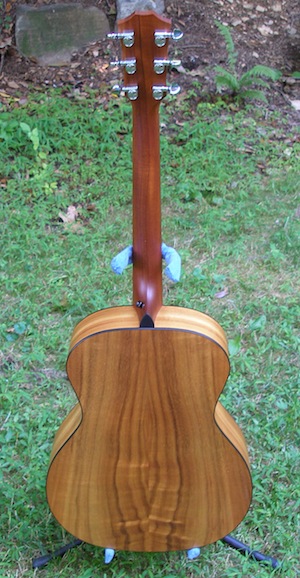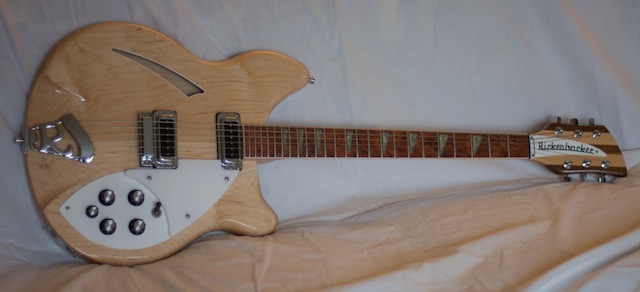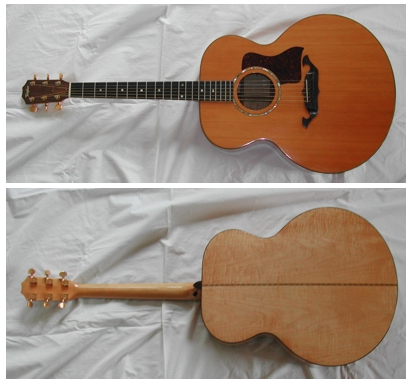The band I play in (as in we've had 3 gigs in 18 months!) is currently configured with three acoustic guitar players, a mandolin player and vocalist, and a multi-instrumentalist (mandolin, banjo, slide guitar, acoustic guitar); sometimes we have a bass player as well. I count as one of the acoustic guitar players, and with three of us it can be too much of the "same thing" if we're all playing in the same position. So last week I decided to change things up and brought out my Santa Cruz Bob Brozman baritone (BBB). I got a great deal on this guitar a few years back, and have primarily kept tuned down to C# (i.e., three half-steps below standard tuning) or D (two half-steps) with standard medium strings. Mine is the standard model with the back and sides made from mahogany and a sitka spruce top, rather than the pricier koa and German spruce models. Unlike the one pictured below, mine came with a factory pickguard.
 To compliment the band, I decided to throw heavier "baritone"-gauged strings on the BBB and tuned down to B. I figured that this would work best in terms of being able to play along with most of our songs while staying in common chord shapes. B is pretty low for an instrument with a 27" scale; most baritones that go down that low are 28-29". Before I got the BBB, I had a maple-bodied Tacoma baritone with a 29" scale, and I found it to be more than I could handle, both on the left hand and also in terms of the large body. So when I had the opportunity to get the BBB (at a great price), I jumped at it because it's a much more manageable instrument.
To compliment the band, I decided to throw heavier "baritone"-gauged strings on the BBB and tuned down to B. I figured that this would work best in terms of being able to play along with most of our songs while staying in common chord shapes. B is pretty low for an instrument with a 27" scale; most baritones that go down that low are 28-29". Before I got the BBB, I had a maple-bodied Tacoma baritone with a 29" scale, and I found it to be more than I could handle, both on the left hand and also in terms of the large body. So when I had the opportunity to get the BBB (at a great price), I jumped at it because it's a much more manageable instrument.
I was suprised that the BBB took the B tuning pretty well. The low B string wasn't too floppy and actually had more punch than I was expecting. It certainly doesn't blow the roof off or rumble the house's foundation, but it is satisfying and mixed in with the other instruments in the band well. So I'm well on my way to becoming my band's baritone guitar player...
Although the BBB works well, given my bouts with G.A.S., I started thinking about the other baritones out there. As well as the BBB fits the bill, I like it in C# or D tuning, and wondered if I should leave it there and find another baritone to take down to B. Since B and C#/D need different string gauges, it's not easy to go between them. Maybe I need two baritones...One for B and another for C#/D?
The Taylor Baritone is an interesting model in that it is 27" scale, designed to go down to B. There are also two models, a standard 6-string and a 8-string that includes octave strings for the 3rd and 4th strings (akin to a 12-string guitar). The idea is that the two octave strings add some "sparkle. So, in theory it would make a great second baritone since it would give a different tuning (B...so I could return the BBB to C#), has the octave strings for variety, and has a pickup (i.e., good for playing out).
I tracked an 8-string Taylor Baritone down at a local shop. I've had a few Taylors in the past, but haven't really been into them in about 10 years. I was shocked to see how much the Taylor line has expanded since I got my 355 12-string in 1998; it was overwhelming. The number of Martin models has similarly grown, although though I have (mostly) kept up with those lines. The 8-string Taylor is a really elegant guitar; it seems similarly appointed to the 800-series (i.e., rosewood, abolone rosette). At one point I was enamoured with a Taylor 814 (although I never did get one); this guitar seems like a slightly oversized version of that guitar, although it's surprisingly comfortable to play. It certainly not as cumbersome as the Tacoma baritone.
Overall, it's a nice sounding guitar. I really like the octave strings; I don't play my 355 much anymore, but this seemed to have just enough of that 12-string sound to be interesting without being overwhelming. Surprisingly (or maybe not, given the physics of such things), the low B wasn't particularly strong. My BBB hits that low note better. Other than that I enjoyed the tone of the guitar and the weak bass wouldn't be a total dealbreaker since that could be boosted when playing amplified (I assume...I didn't play with the ES pickup system that comes standard on the Baritone).

So, why didn't the Taylor Baritone come home with me? It came down to playability. First, the octave string that was paired with the 4th string buzzed whenever/however I put a capo in it. Still not a dealbreaker; I assume that could be addressed with a set up or minor adjustment. The surprising thing that made this a no-go for me was the neck width. The Taylor comes standard with 1.75" width at the nut, which is typically my preference (note: the BBB is 1-7/8"). But with those extra octave strings in squeezed in there, it just feels too cramped. With a slightly wider neck, it might have pulled the trigger. Yes, I know that Taylor has a "build to order" custom shop and probably would do a wide-necked 8-string, but I'm not quite ready to commit to that...
So, the bottom line:
- The Santa Cruz Brozman is an awsome baritone guitar. It works for my down to B with baritone gauge strings, but it really shines at C# or D with medium gauge strings.
- I like the tonal variety offered by the Taylor 8-string, although it's acoustically not as good as the SCGC BBB (but it is about half the price!). If it came with a wider neck, I'd be temped to get one and maybe let my 12-string go.
Update: 11/6/15
When I was in London last month I played a Lowden baritone guitar at No.Tom Vintage & Classic Guitars. What a fabulous instument! In particular, I found to the bass (tuned down to B) to be more defined and punchy than my Santa Cruz. I came close to pulling the trigger but ulitmately didn't do it; someone picked up a killer guitar. If you are looking for a baritone, definitely check out the offering from Lowden.
 image from: http://notomguitars.com/products/2011-lowden-barritone
image from: http://notomguitars.com/products/2011-lowden-barritone
 Wednesday, November 13, 2013 |
Wednesday, November 13, 2013 |  Post a Comment | tagged
Post a Comment | tagged  environmentalism,
environmentalism,  gibson,
gibson,  guitar,
guitar,  martin,
martin,  taylor
taylor 













